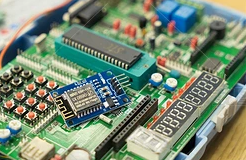Copper overlay is an important part of PCB design. The so-called copper pour is to fill the free space above the PCB with solid copper, also called copper pour.
The significance of the copper clad is to reduce the impedance of the ground wire, improve the anti-interference ability, reduce the voltage drop, and improve the power efficiency, and the connection with the ground wire can also reduce the loop area. In order to make the printed circuit board not deform as much as possible during the soldering process, most printed circuit board manufacturers will also require the printed circuit board designer to fill the open area of the printed circuit board with copper plates or grid-like ground wires.
As we all know, under high frequency conditions, the distributed capacitance of the wiring on the printed circuit board will work. When the length is greater than 1/20 of the wavelength corresponding to the noise frequency, an antenna effect will occur, and noise will be emitted to the outside through the wiring. If there is a copper-clad layer in the PCB and the grounding is poor, the copper-clad layer will become a tool for transmitting noise.
Therefore, in a high-frequency circuit, don't think that some place of the ground wire is grounded, this is the "ground wire". Drill holes must be drilled in the PCB wiring, with a spacing less than λ/20, and "good grounding" with the ground plane of the multilayer board. If the copper clad is handled properly, it will not only increase the current, but also play a dual role in shielding interference.
There are two basic copper pour methods: large area copper pour and grid copper pour. People often ask whether to cover a large area with copper or to cover the power grid with copper. It's not easy to sum up!

Large-area copper plating has the dual functions of increasing current and shielding, but if large-area copper plating is passed through wave soldering, it may warp or even blistering the board. Therefore, for large-area copper plating, there are usually several grooves to relieve the blistering of the copper foil. Pure grid copper plating is mainly a shielding effect, and the effect of increasing the current is reduced. From the perspective of heat dissipation, the grid is OK. It reduces the heating surface of copper 41 and plays a certain role in electromagnetic shielding.
However, it should be noted that the grid is composed of staggered lines. We know that for the circuit, the width of the circuit has a corresponding "electrical length" to the operating frequency of the circuit board; the actual size can be obtained by dividing by the digital frequency corresponding to the operating frequency, which can be found in related books See &; 41; when the operating frequency is not very high, it may be that the function of the grid line is not very obvious. Once the electrical length matches the operating frequency, it is terrible. You will find that the circuit is not working properly at all, and the signals that interfere with the operation of the system are being transmitted everywhere. Therefore, for users who use grid copper clad laminates, I suggest choosing them based on the working conditions of the designed circuit boards.
Therefore, high-frequency circuits require multiple-gate copper clad laminates, while high-current low-frequency circuits usually have complete copper clad laminates.
In order to achieve the expected PCB copper pour effect, the following issues need to be paid attention to:
1. Problems in the copper-clad process. If there are multiple PCBs, such as sgnd, agnd, gnd, etc., you need to use the main "ground" as the reference for independent copper clad according to the different positions of the PCB, and separate the digital and analog clad copper. At the same time, after copper plating, thicken the corresponding power cords: 5.0V, 3.3V, etc., so that a variety of deformed structures with different shapes are formed.
2. For single-point connection of different grounds, the method is to connect via 0 ohm resistor or magnetic beads or inductance. The crystal oscillator adjacent to the PCB copper clad. The crystal oscillator in the circuit is a high-frequency emission source. The method is to wrap the crystal oscillator with copper, and then ground the shell of the crystal oscillator separately.
Four. Isolated island 40; dead zone 41; if you think it's large, it won't cost much to define a hole to be added.
5 pcs. When starting wiring, the ground wire should be treated the same. When wiring, the grounding wire should work well. Adding a through hole after the copper pour cannot eliminate the ground pin. This effect is not good.
6. Try not to have sharp corners on the board, because from an electromagnetic point of view, it is recommended to use round edges along the line of the transmitting antenna.
Number 7. The open area of the wiring under the PCB multilayer board should not be covered with copper. Because it is difficult for you to make this copper-clad "good ground".
8. The metal outside the device, such as metal radiators, metal reinforcement strips, etc., must be well grounded.
No.9. The heat dissipation metal block of the three-terminal voltage regulator must be well grounded. The ground isolation strip adjacent to the crystal oscillator must be well grounded.